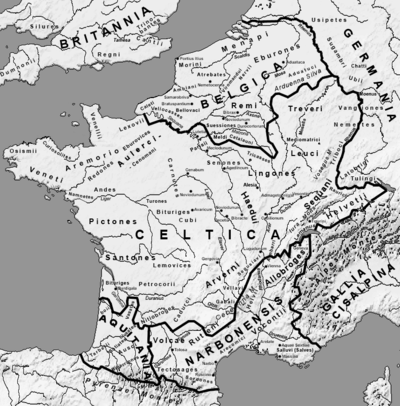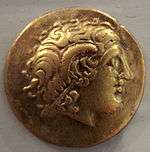Segusiavi
The Segusiavi (Gaulish: 'the Victorious Ones')[1] were a Gallic tribe around the modern city of Feurs.[2]

Name
They are mentioned as Segusiavis by Caesar (mid-1st c. BC),[3] as Segosianō͂n (Σεγοσιανῶν) by Strabo (early 1st c. AD),[4] as Segusiavi by Pliny (1st c. AD),[5] and as Segousō̃antoi (Σεγουσῶαντοι) by Ptolemy (2nd c. AD).[6][2]
The name Segusiavi stems from Gaulish sego- ('victory, force').[7] The second element -siavi is unclear.[2] Segusiavi , who by then possessed a wide area just north of the Greek colony of Massalia may have been an alternative name of the Segobriges, involved in the legendary foundation myth of the city.[8]
The city of Feurs, attested as Foros Segusiavon in the 2nd century CE ('forum, market of the Segusiavi', Forum in 950, Fuer in 1227) is ultimately named after the Gallic tribe.[9]
References
- Ó Hogain, Daithi; Ó hÓgáin, Dáithí (2003). The Celts: A History. Boydell Press. p. 127. ISBN 978-0-85115-923-2.
- Falileyev 2010, p. entry 3920a.
- Caesar. Commentarii de Bello Gallico, 7:64:4; 7:75:2
- Strabo. Geōgraphiká, 4:1:11
- Pliny. Naturalis Historia, 4:18:107
- Ptolemy. Geōgraphikḕ Hyphḗgēsis, 2:8:11
- Delamarre 2003, p. 269.
- Ó Hogain, Daithi; Ó hÓgáin, Dáithí (2003). The Celts: A History. Boydell Press. p. 27. ISBN 978-0-85115-923-2.
- Nègre 1990, p. 359.
Bibliography
- Delamarre, Xavier (2003). Dictionnaire de la langue gauloise: Une approche linguistique du vieux-celtique continental (in French). Errance. ISBN 9782877723695.CS1 maint: ref=harv (link)
- Falileyev, Alexander (2010). Dictionary of Continental Celtic Place-names: A Celtic Companion to the Barrington Atlas of the Greek and Roman World. CMCS. ISBN 978-0955718236.
- Nègre, Ernest (1990). Toponymie générale de la France (in French). Librairie Droz. ISBN 978-2-600-02883-7.CS1 maint: ref=harv (link)
See also
- List of peoples of Gaul
